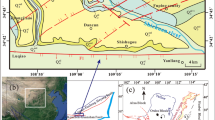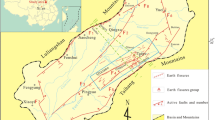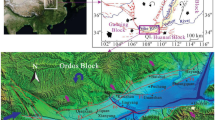Abstract
The Fenwei Graben System is an important extensional fault-depression zone, which is the tectonic boundary between the Ordos Block and the South China Block and the North China Block. The graben system presents an “S” shape, with a total length of 1200 km and a width of 30–60 km and an overall strike of NNE. Due to complex tectonic background and active faults, nearly 612 ground fissures develop in these basins, and more than 90% of these ground fissures are tectonic fissures, which are closely associated with fault activities. To reveal the plane symbiotic phenomena, profile symbiotic modes and symbiotic mechanism between tectonic fissures and faults in the Fenwei Graben System, the developmental characteristics were investigated in detail by surveying, map**, trenching and drilling in the study area. The main conclusions are as follows. (1) The tectonic fissures of the Fenwei Graben System are mainly distributed along the margin faults of basins, the boundary faults between blocks and the hidden faults within blocks, causing serious damages to farmlands, houses and roads. The symbiosis between these fissures and faults is obvious on the surface. (2) The profile symbiotic morphology includes vertical extension type, syncline and anticline “y” type, and stepped type. (3) The symbiotic mechanisms include vertical growth, lateral rupture and clustery derivation. (4) The activities of underlying faults give impetus to the formation and expansion of tectonic fissures. The exposure of the fissures makes underlying faults continue to develop in the form of surface fractures.














Similar content being viewed by others
References
Ayalew L et al (2004) Ground cracks in Ethiopian Rift Valley: facts and uncertainties. Eng Geol 75(3–4):309–324
Deng AS, Ju JH (1994) Land subsidence, sinkhole collapse and earth fissure occurrence and control in China. Hydrol Sci J 39(3):245–256
Deng YH et al (2013) Experiment research on dynamic characteristics of ground fissure belt loess in ** 'an area. Appl Mechan Mater 387:138–146
Earl HP et al (1988) Modern ground failure in the Garlock fault zone, Fremont Valley, California. Geol Soc Am Bull 100:677–691
Howard KWF, Zhou WF (2019) Overview of ground fissure research in China. Environm Earth Sci 78(97)
Jia ZJ et al (2020) Analysis and comparison of two types of ground fissures in Dali County in the Weihe Basin. China Environm Earth Sci 79:38
Lee CF et al (1996) Evolution and origin of the ground fissures in **'an, China. Eng Geol 43:45–55
Li YL et al (2000) Origin of ground fissures in the Shanxi Graben System. Northern China Eng Geol 55(2000):267–275
Martin HM, Thomas JB (2010) Controls on initiation and propagation of pum**-induced earth fissures: insights from numerical simulations. Hydrogeol J 18(8):1773–1785
Mohseni N, et al. (2017) Variations in spatial patterns of soil–vegetation properties over subsidence-related ground fissures at an arid ecotone in northeastern Iran. Environm Earth Sci 76(234)
Peltzer G, Tapponnier P (1988) Formation and evolution of strike-slip faults, rifts, and basins during the India-Asia Collision: An experimental approach. J Geophys Res 93(B12):15085–15117
Peng JB et al (2016a) Characteristics and mechanism of the Longyao ground fissure on North China Plain, China. Eng Geol 214:136–146
Peng JB, et al. (2016b) Distribution and mechanism of the ground fissures in Wei River Basin, the origin of the Silk Road. Environm Earth Sci 75(718)
Peng JB et al (2016b) Characteristics of land subsidence, earth fissures and related disaster chain effects with respect to urban hazards in **’an. China Environm Earth Sci 75(16):1190
Peng JB et al (2018) Characteristics and mechanism of Sanyuan ground fissures in the Weihe Basin, China. Eng Geol 247:48–57
Peng JB, et al. (2018b) Development characteristics and mechanisms of the Taigu–Qixian earth fissure group in the Taiyuan basin, China. Environm Earth Sci 77(407)
Peng JB et al (2020a) Characteristics and mechanisms for origin of earth fissures in Fenwei basin. China Eng Geol 266:105445
Peng JB et al (2020b) Distribution and generative mechanisms of ground fissures in China. J Asian Earth Sci 191:104218
Qiao JW, et al. (2018) Earth fissures in Qinglong Graben in Yuncheng Basin, China. J Earth Syst Sci 127(10)
Qu FF et al (2014a) Land subsidence and ground fissures in **'an, China 2005–2012 revealed by multi-band InSAR time-series analysis. Remote Sens Environ 155:366–376
Qu W et al (2014b) Kinematic model of crustal deformation of Fenwei basin, China based on GPS observations. J Geodyn 75:1–8
Wang FY et al (2019a) Mechanism of Fu** ground fissure in the Weihe Basin of northwest China: fault and rainfall. Environm Earth Sci 78:407
Wang FY et al (2019b) The origin and impact of the Shizhuang ground fissure, Yingxian area, Datong Basin. China Eng Geol 261:105283
William CH et al (1995) Tilts, strains, and ground-water levels near an earth fissure in the Mimbres Basin. New Mexico GSA Bull 107(3):316–326
Williams FM et al (2004) Tensional fissures and crustal extension rates in the northern part of the Main Ethiopian Rift. J Afr Earth Sci 38(2):183–197
Wu Q et al (2001) Study on simulation of earth-fissures development and prediction based on GIS. Sci China (Series D) 44(1):77–84
Wu Q et al (2003) A nonlinear modeling and forecasting system of earth fractures based on coupling of artificial neural network and geographical information system?exemplified by earth fractures in Yuci City, Shanxi. China Environ Geol 45(1):124–131
Yang CS et al (2014) Monitoring land subsidence and fault deformation using the small baseline subset InSAR technique: A case study in the Datong Basin, China. J Geodyn 75:34–40
Yang CS et al (2018) Deformation at longyao ground fissure and its surroundings, north China plain, revealed by ALOS PALSAR PS-InSAR. Int J Appl Earth Obs Geoinf 67:1–9
Ye SJ et al (2018) A Novel Approach to Model Earth Fissure Caused by Extensive Aquifer Exploitation and its Application to the Wuxi Case. China Water Resour Res 54(3):2249–2269
Zang MD et al (2014) Basement Stretch and Ground Fissures Formation in Linfen Basin. Appl Mechan Mater 711:562–565
Zhang Q et al (2011) Analysis of Present Tectonic Stress and Regional Ground Fissure Formation Mechanism of the Weihe Basin. Survey Rev 43(322):382–389
Zhang Y et al (2007) Land subsidence and earth fissures due to groundwater withdrawal in the Southern Yangtse Delta. China Environ Geol 55(4):751–762
Zhao C et al (2015) Different scale land subsidence and ground fissure monitoring with multiple InSAR techniques over Fenwei basin, China. Proc Int Assoc Hydrol Sci 372:305–309
Acknowledgements
This study was funded by the National Science Foundation of China (NO. 41790441, 41877250, 41807234 and 41272284), the CMEC Technology Incubation Project (CMEC-KJFH-2018-02), the Fundamental Research Funds for the Central Universities, CHD (NO. 300102269203) and the National Geological Survey of China (NO. DD20160264).
Author information
Authors and Affiliations
Corresponding author
Additional information
Publisher's Note
Springer Nature remains neutral with regard to jurisdictional claims in published maps and institutional affiliations.
Rights and permissions
About this article
Cite this article
Wang, F., Xun, S., Peng, J. et al. A study of the symbiotic relationship between tectonic fissures and faults in the Fenwei Graben System, China. Environ Earth Sci 79, 212 (2020). https://doi.org/10.1007/s12665-020-08966-9
Received:
Accepted:
Published:
DOI: https://doi.org/10.1007/s12665-020-08966-9




